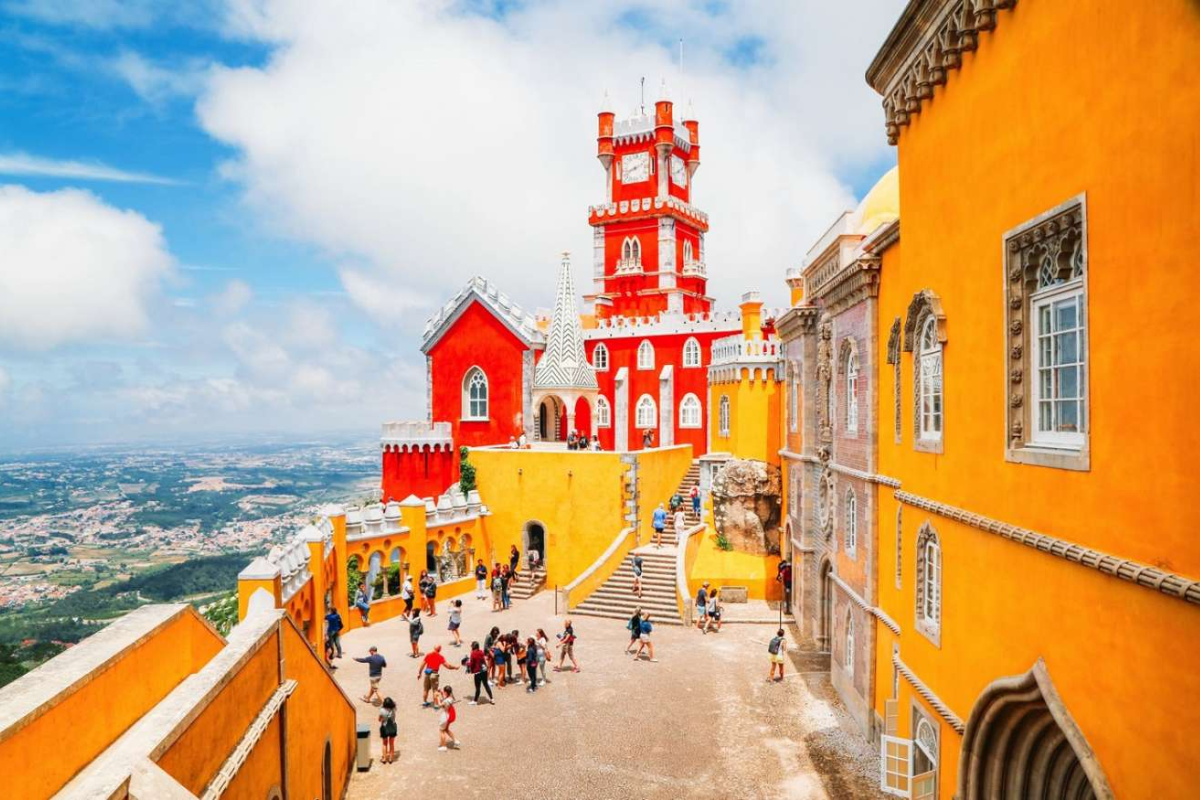Portugal is a captivating country known for its rich history, vibrant culture, best places to visit in portugal, and stunning natural beauty. From historic cities and charming towns to breathtaking beaches and lush landscapes, Portugal offers a diverse range of attractions for every traveler. Whether you’re exploring the bustling streets of Lisbon, savoring the world-famous wines of Porto, or relaxing on the golden sands of the Algarve, there’s something for everyone. This Portugal travel guide will help you discover the best destinations in Portugal, ensuring an unforgettable journey through this enchanting country.
Lisbon: The Vibrant Capital
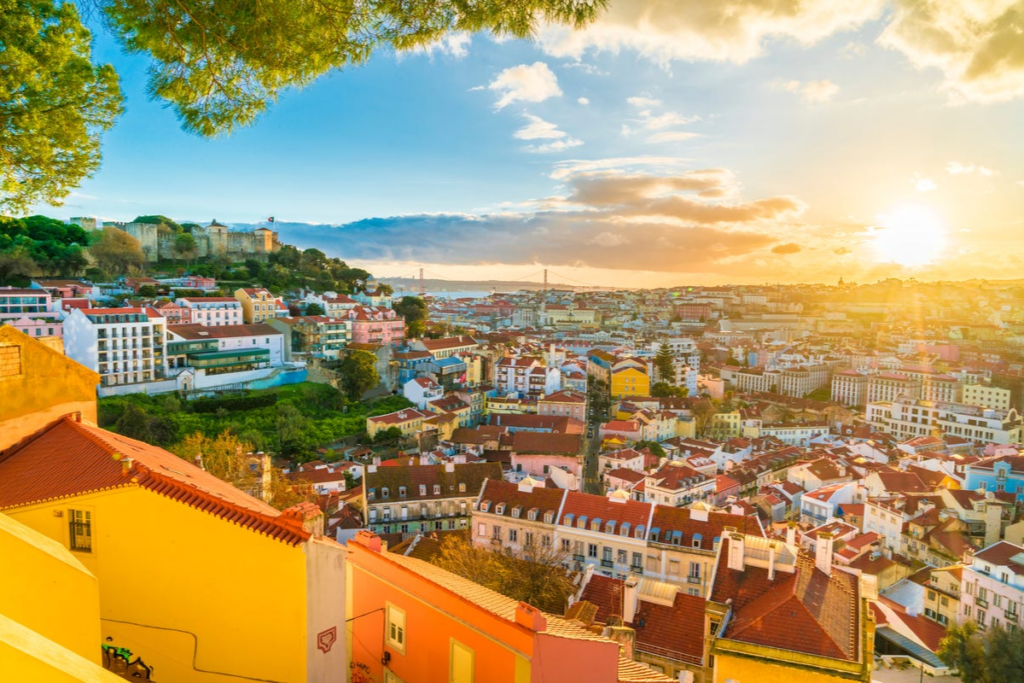
Lisbon, the capital city of Portugal, is a vibrant metropolis brimming with history, culture, and modern charm. Known for its picturesque streets, historic landmarks, and lively neighborhoods, Lisbon offers a unique blend of old-world charm and contemporary flair.
- Belem Tower: A UNESCO World Heritage site, Belem Tower is an iconic symbol of Lisbon’s maritime history. Built in the 16th century, this fortress offers stunning views of the Tagus River and the city.
- Jeronimos Monastery: Another UNESCO World Heritage site, Jeronimos Monastery is a masterpiece of Manueline architecture. The intricate carvings and stunning cloisters make it a must-visit attraction.
- Alfama District: The oldest neighborhood in Lisbon, Alfama is known for its narrow winding streets, traditional Fado music, and stunning viewpoints like Miradouro da Senhora do Monte.
- Tram 28: Experience the charm of Lisbon by riding Tram 28, which takes you through some of the city’s most historic and scenic areas.
Best time to visit Lisbon: The best time to visit Lisbon is during the spring (March to May) or fall (September to October) when the weather is mild, and the crowds are smaller.
Porto: The Wine Lover’s Paradise
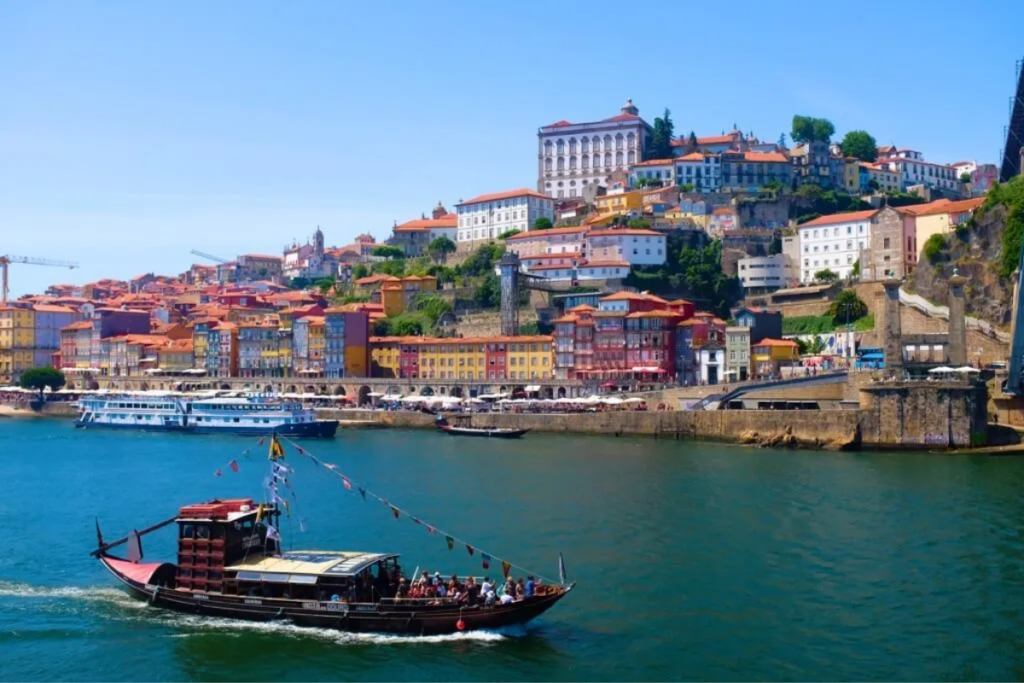
Porto, the second-largest city in Portugal, is renowned for its rich wine culture, particularly its production of Port wine. This charming city, located along the Douro River, offers a blend of historic charm, vibrant culture, and stunning architecture.
- Ribeira District: The Ribeira District is a UNESCO World Heritage site and one of the most picturesque areas in Porto. Its narrow, winding streets are lined with colorful buildings, lively cafes, and traditional restaurants. Stroll along the waterfront and soak in the vibrant atmosphere.
- Dom Luis I Bridge: This iconic double-deck iron bridge spans the Douro River, connecting Porto with Vila Nova de Gaia. Designed by a disciple of Gustave Eiffel, the bridge offers spectacular views of the river and the city. Walking across it is a must-do experience.
- Livraria Lello: Often considered one of the most beautiful bookstores in the world, Livraria Lello boasts stunning neo-Gothic architecture, a majestic staircase, and intricate wooden carvings. It’s a paradise for book lovers and a popular tourist attraction.
- Porto Cathedral: Also known as Sé do Porto, this Romanesque cathedral is one of the city’s oldest monuments. The cathedral’s fortress-like structure, beautiful rose window, and panoramic views from its terrace make it a must-visit site.
A visit to Porto wouldn’t be complete without exploring its famous wine cellars. Located in Vila Nova de Gaia, just across the river from Porto, these cellars offer guided tours and tastings of the city’s renowned Port wine. Learn about the wine-making process, the history of Port wine, and enjoy sampling different varieties. Popular cellars to visit include Sandeman, Graham’s, and Taylor’s.
Sintra: A Fairy Tale Town
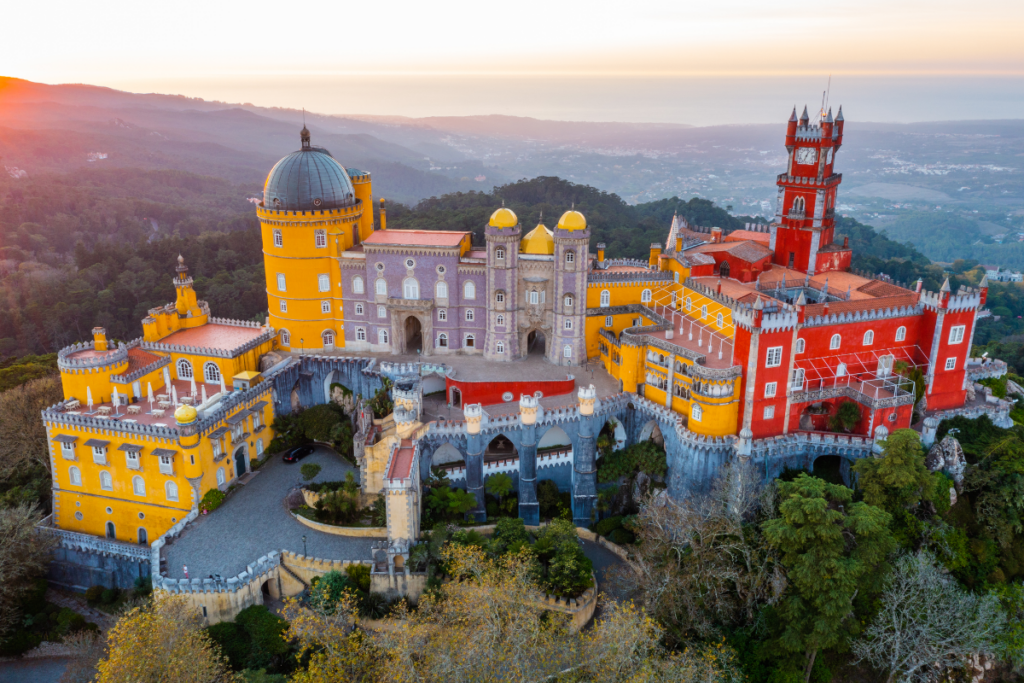
Sintra, located just a short drive from Lisbon, is a magical town that seems straight out of a fairy tale. Nestled in the hills of the Sintra Mountains, this enchanting destination is known for its lush landscapes, stunning palaces, and mystical ambiance. Sintra has long been a favorite retreat for Portuguese royalty and nobility, and it’s easy to see why.
- Pena Palace: One of the most iconic landmarks in Sintra, Pena Palace is a colorful and eclectic palace that sits atop a hill, offering breathtaking views of the surrounding area. The palace’s whimsical architecture and lush gardens make it a must-visit.
- Moorish Castle: Perched high on a hill, the Moorish Castle dates back to the 8th century and offers panoramic views of Sintra and the Atlantic Ocean. The ancient walls and towers provide a fascinating glimpse into Portugal’s past.
- Quinta da Regaleira: This mysterious estate is famous for its romantic gardens, hidden tunnels, and the enigmatic Initiation Well. Quinta da Regaleira is a place where myth and reality blend seamlessly, offering visitors a sense of wonder and exploration.
Tips for a Day Trip from Lisbon
- Getting There: Sintra is easily accessible from Lisbon by train. The journey takes about 40 minutes, with frequent departures from Rossio Station.
- Start Early: To make the most of your day trip, start early in the morning to avoid the crowds and have enough time to explore the main attractions.
- Wear Comfortable Shoes: Sintra’s attractions are spread out, and there is a fair amount of walking involved, especially if you plan to hike up to the Moorish Castle or explore the gardens of Quinta da Regaleira.
- Pack a Picnic: Enjoy a leisurely lunch in one of Sintra’s many scenic spots. There are plenty of picnic areas within the parks and gardens.
- Buy Tickets in Advance: To save time and avoid long lines, consider purchasing tickets for Pena Palace and Quinta da Regaleira online in advance.
Sintra is undoubtedly one of the top places to visit in Portugal, offering a unique blend of natural beauty, historical intrigue, and fairy tale charm.
Algarve: Stunning Beaches and Cliffs
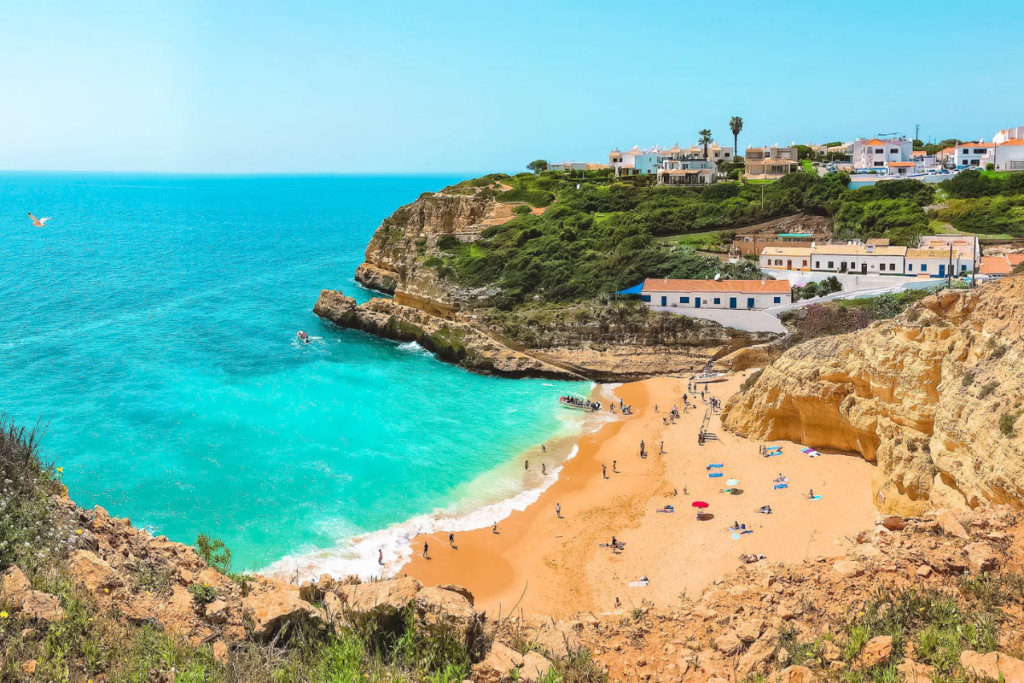
The Algarve region, located in the southernmost part of Portugal, is renowned for its breathtaking beaches, dramatic cliffs, and charming coastal towns. With over 300 days of sunshine a year, the Algarve is a paradise for beach lovers and outdoor enthusiasts alike. This Portugal travel guide highlights the best destinations in Portugal, and the Algarve undoubtedly tops the list for its natural beauty and vibrant atmosphere.
Best Beaches to Visit
- Praia da Marinha: Often cited as one of the most beautiful beaches in the world, Praia da Marinha is known for its crystal-clear waters, golden sands, and impressive limestone cliffs. It’s a perfect spot for sunbathing, swimming, and snorkeling.
- Benagil Cave: This iconic sea cave, accessible by boat or kayak, is a must-see in the Algarve. The cave’s natural skylight and serene beach inside create a magical setting that attracts visitors from around the globe.
- Praia da Rocha: One of the most popular beaches in the Algarve, Praia da Rocha offers wide stretches of sandy shore, vibrant nightlife, and plenty of restaurants and bars. The nearby Fort of Santa Catarina provides panoramic views of the coastline.
Outdoor Activities
- Surfing: The Algarve is a top surfing destination in Europe, with spots like Arrifana Beach and Amado Beach offering excellent waves for all skill levels. Surf schools and rental shops are abundant, making it easy for beginners to join in the fun.
- Cliff Walking: The stunning cliffs of the Algarve provide numerous hiking trails with breathtaking views of the Atlantic Ocean. The Seven Hanging Valleys Trail is particularly popular, taking you along the rugged coastline from Praia da Marinha to Praia de Vale Centeanes.
- Dolphin Watching: The warm waters of the Algarve are home to various marine life, including dolphins. Boat tours from towns like Albufeira and Lagos offer the chance to see these playful creatures in their natural habitat, often combined with trips to hidden caves and secluded beaches.
The Algarve is truly one of the top places to visit in Portugal, offering a perfect blend of relaxation and adventure. Whether you’re lounging on pristine beaches, exploring sea caves, or riding the waves, the Algarve promises an unforgettable experience.
Madeira: The Island of Eternal Spring
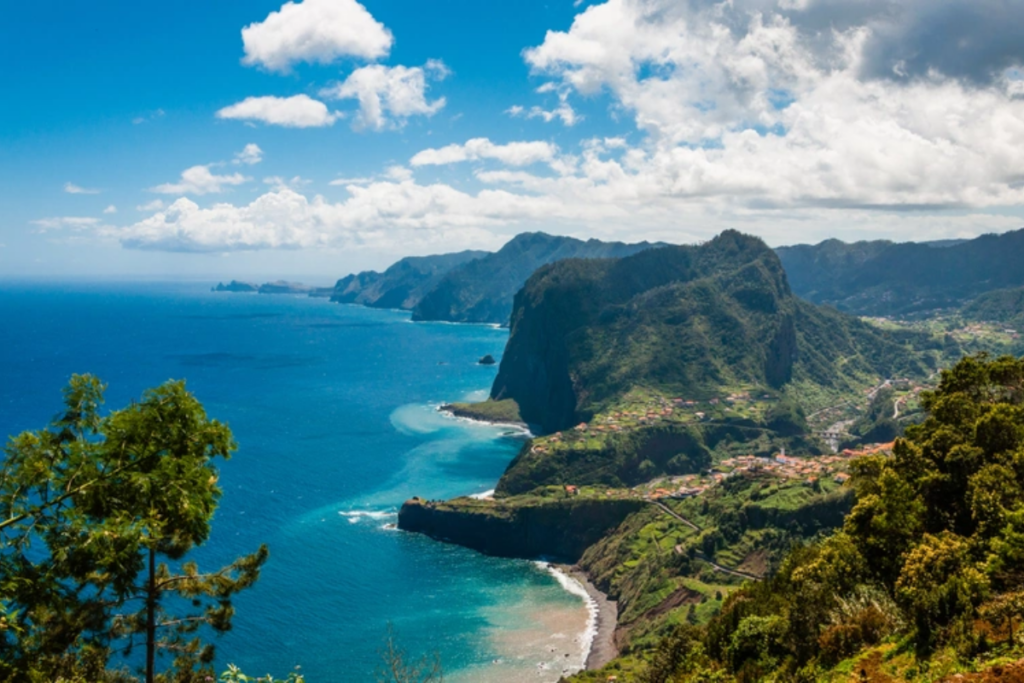
Madeira, often referred to as the “Island of Eternal Spring,” is a breathtaking archipelago known for its mild climate, stunning landscapes, and vibrant flora. This Portuguese island is a paradise for nature lovers and adventure seekers alike, offering lush forests, dramatic cliffs, and picturesque villages. Madeira’s unique climate ensures that flowers bloom year-round, making it a haven for those seeking natural beauty and tranquility.
Highlights
- Laurisilva Forest: A UNESCO World Heritage site, the Laurisilva Forest is a lush subtropical rainforest that covers much of Madeira. Home to an incredible variety of endemic plant and animal species, it offers numerous hiking trails that allow visitors to immerse themselves in its enchanting beauty.
- Cabo Girão Skywalk: One of the highest sea cliffs in Europe, Cabo Girão features a thrilling glass skywalk that extends out over the edge, offering breathtaking views of the ocean and the landscape below. It’s a must-visit spot for those seeking an adrenaline rush and unforgettable photo opportunities.
- Levadas Walks: Madeira is famous for its network of Levadas, which are irrigation channels that crisscross the island. These Levadas provide scenic walking trails through lush valleys, rugged mountains, and serene countryside. Popular Levadas walks include the Levada do Caldeirão Verde and the Levada das 25 Fontes.
Best Time to Visit and Travel Tips
Best Time to Visit: Madeira enjoys a mild climate year-round, but the best time to visit is during the spring (March to May) and fall (September to November) when temperatures are pleasant, and the island is less crowded. These periods also offer the best conditions for hiking and exploring the outdoors.
Travel Tips
Transportation: Renting a car is the best way to explore Madeira’s diverse landscapes and remote areas. Public transportation is available but may not reach all the scenic spots.
Accommodation: Funchal, the capital of Madeira, offers a wide range of accommodation options, from luxury hotels to charming guesthouses. Staying in Funchal provides easy access to many of the island’s attractions.
Local Cuisine: Don’t miss trying Madeira’s local specialties, such as Espetada (grilled beef skewers), Bolo do Caco (traditional bread), and the famous Madeira wine..
Azores: A Natural Wonder
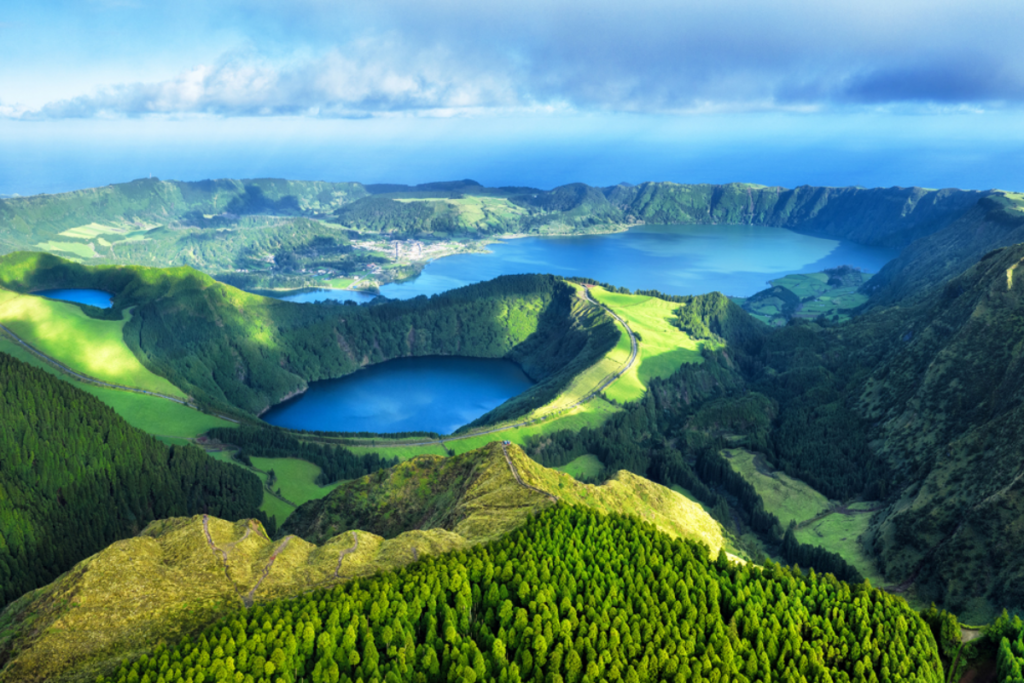
The Azores archipelago, located in the middle of the Atlantic Ocean, is a haven of natural beauty and adventure. Comprising nine volcanic islands, the Azores offer stunning landscapes, lush greenery, and unique geological features. This Portugal travel guide highlights the top places to visit in the Azores, making it an essential part of your itinerary.
Top Islands to Visit
- São Miguel: Known as the “Green Island,” São Miguel is the largest and most diverse island in the Azores. Key attractions include the Sete Cidades twin lakes, Lagoa do Fogo, and the Terra Nostra Garden. Ponta Delgada, the island’s capital, offers charming streets, historic buildings, and vibrant markets.
- Pico: Dominated by the majestic Pico Mountain, the highest peak in Portugal, Pico Island is a paradise for nature lovers and adventurers. Visitors can hike to the summit of Pico Mountain, explore the UNESCO-listed Pico Vineyards, and enjoy the island’s rugged coastline.
- Terceira: Rich in history and culture, Terceira Island is home to the UNESCO World Heritage site of Angra do Heroísmo, a beautifully preserved historic town. Other highlights include the Algar do Carvão volcanic cave and the lively festivities of the Sanjoaninas Festival.
Activities
- Whale Watching: The Azores are one of the best destinations in Portugal for whale watching. These waters are home to a variety of marine life, including sperm whales, blue whales, and dolphins. Whale watching tours are available from several islands, offering unforgettable encounters with these magnificent creatures.
- Hiking: The diverse landscapes of the Azores provide excellent hiking opportunities. Trails range from easy walks through lush forests to challenging hikes up volcanic peaks. Popular hikes include the Caldeira do Faial, the Serra do Topo on São Jorge, and the Lagoa das Furnas on São Miguel.
- Hot Springs: The volcanic activity in the Azores has created numerous hot springs and geothermal pools, perfect for relaxation. The most famous hot springs are found in Furnas on São Miguel, where you can soak in the warm, mineral-rich waters surrounded by beautiful gardens.
The Azores are a natural wonder, offering a unique and unforgettable experience for travelers seeking adventure and tranquility. Plan your visit to this stunning archipelago and discover why it is one of the top places to visit in Portugal.
Coimbra: The Historical University Town
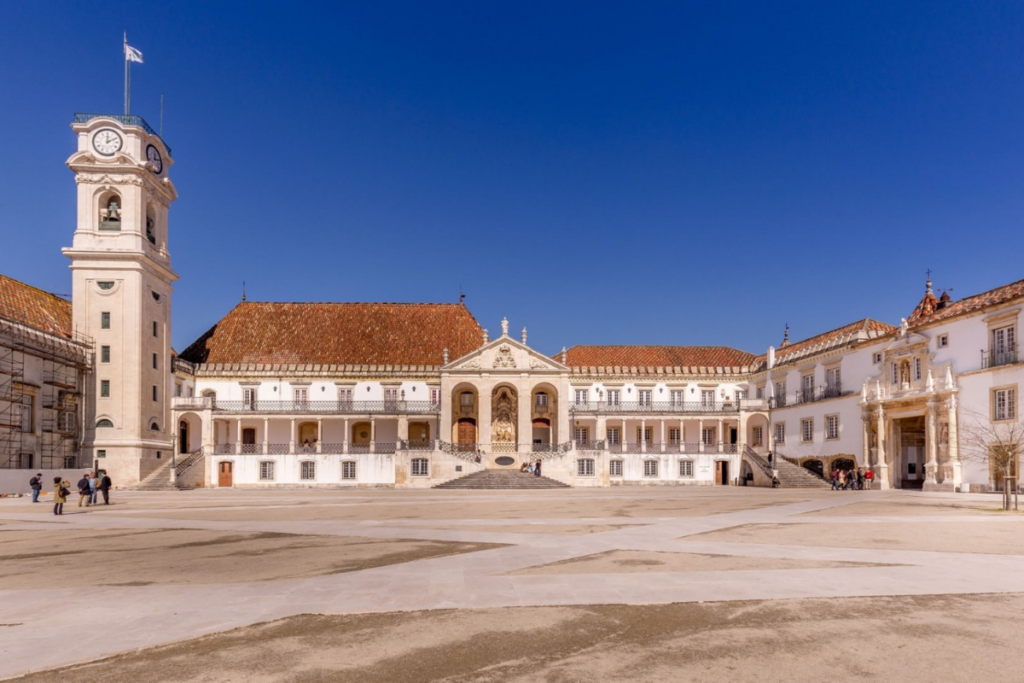
Coimbra, one of the oldest cities in Portugal, is renowned for its historical significance and vibrant academic atmosphere. Home to the prestigious University of Coimbra, this charming town boasts a rich cultural heritage and a lively student population that adds to its unique character.
Brief History of Coimbra and Its University
Founded in 1290, the University of Coimbra is one of the oldest universities in Europe and a UNESCO World Heritage site. Originally established in Lisbon, the university was permanently relocated to Coimbra in 1537. Over the centuries, it has played a pivotal role in the development of Portuguese education and culture, producing many notable scholars and contributing significantly to the country’s intellectual legacy.
Key Attractions in Coimbra
- University of Coimbra: A visit to Coimbra is incomplete without exploring its historic university. The university complex features impressive architecture, including the stunning Royal Palace, which now houses the Rector’s Office and several academic departments.
- Biblioteca Joanina: Located within the University of Coimbra, the Biblioteca Joanina is a magnificent Baroque library renowned for its opulent interiors and vast collection of rare books. Built in the 18th century, it is considered one of the most beautiful libraries in the world.
- Old Cathedral of Coimbra (Sé Velha): The Old Cathedral, built in the Romanesque style, dates back to the 12th century. Its fortress-like appearance and intricate carvings make it a significant historical and architectural landmark.
Cultural Significance and Annual Events
Coimbra is a city steeped in tradition, and its cultural significance is reflected in various annual events and festivities. One of the most notable events is the Queima das Fitas, held in May. This week-long celebration marks the end of the academic year for university students and features parades, concerts, and symbolic burning of ribbons. Another important event is the Festas da Rainha Santa Isabel, a religious festival held every two years in honor of Queen Saint Isabel, the city’s patron saint. The festival includes processions, fireworks, and various cultural activities.
Coimbra’s blend of historical charm, academic excellence, and cultural vibrancy makes it one of the top places to visit in Portugal. Whether you’re wandering through its ancient streets or immersing yourself in its rich academic traditions, Coimbra offers a truly unique and enriching travel experience.
Évora: A Journey Through Time
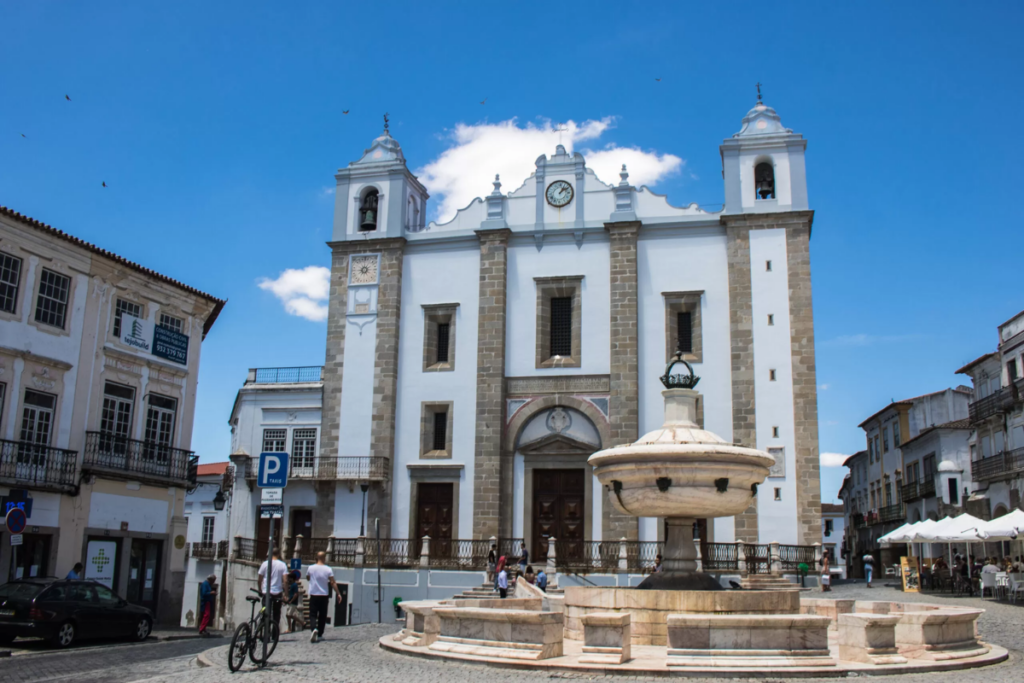
Évora, a UNESCO World Heritage site, is a city steeped in history, where ancient monuments and architectural marvels stand as a testament to its rich cultural heritage. Located in the heart of the Alentejo region, Évora is often referred to as an open-air museum, offering visitors a glimpse into Portugal’s past.
Rich History of Évora
Évora’s history dates back over 2,000 years, with its roots in Roman times. The city flourished during the Roman Empire and later became a significant center during the medieval period. As you wander through its cobbled streets, you’ll encounter remnants of Roman, Moorish, and Christian influences, each contributing to the city’s unique character.
Must-See Sites in Évora
- Roman Temple: Also known as the Temple of Diana, this ancient structure is one of the best-preserved Roman ruins in Portugal. Built in the 1st century AD, the temple stands as a remarkable example of Roman architecture and is a central attraction in Évora.
- Évora Cathedral: Dominating the city’s skyline, the Évora Cathedral (Sé de Évora) is the largest medieval cathedral in Portugal. Constructed in the 12th century, its Gothic and Romanesque elements make it a stunning piece of architectural history. Don’t miss the panoramic views from the rooftop.
- Chapel of Bones (Capela dos Ossos): Perhaps one of the most intriguing sites in Évora, the Chapel of Bones is adorned with the bones of thousands of monks. The chilling yet fascinating chapel is a reflection on the transience of life and is a must-visit for those interested in unique historical experiences.
Best Time to Visit and Tips for Tourists
The best time to visit Évora is during the spring (March to May) or fall (September to October) when the weather is pleasant, and the city is less crowded. Summers can be extremely hot, so if you plan to visit during this time, be prepared for high temperatures.
Travel Tips:
Explore beyond the main attractions: While the main sites are impressive, take time to explore the smaller streets and hidden corners of the city for a more intimate experience.
Wear comfortable shoes: Évora’s cobblestone streets can be uneven, so comfortable footwear is essential.
Stay hydrated: Especially important if you visit during the warmer months.
Take a guided tour: To fully appreciate the historical significance of Évora’s landmarks, consider taking a guided tour.
Aveiro: The Venice of Portugal
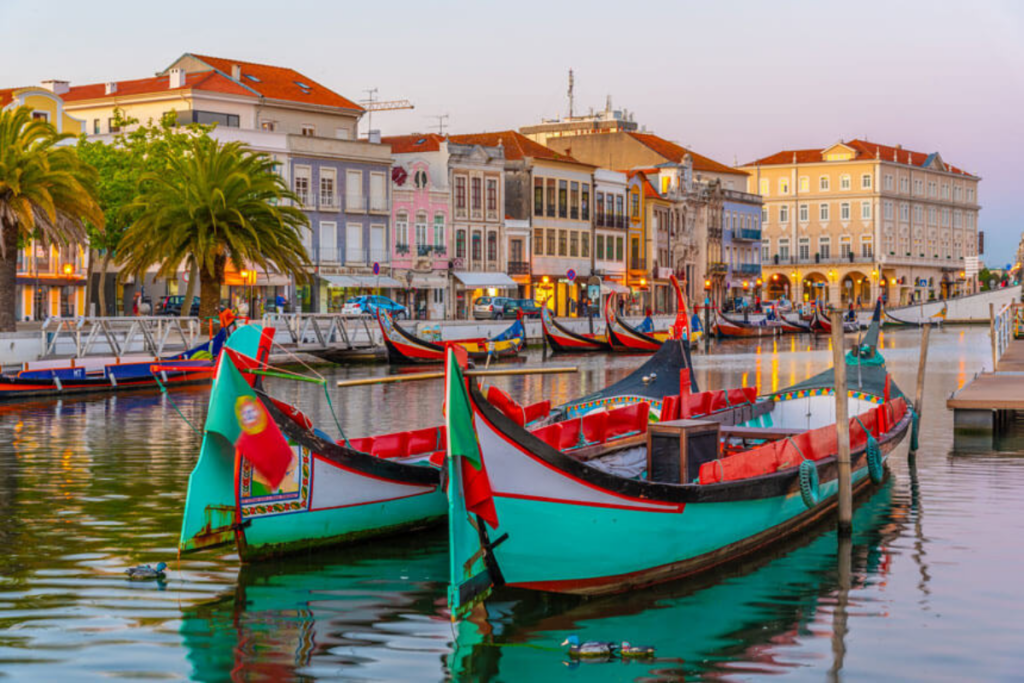
Aveiro, often referred to as the “Venice of Portugal,” is a picturesque city known for its charming canals, colorful boats, and stunning Art Nouveau architecture. Located on the west coast of Portugal, this coastal gem offers a unique blend of history, culture, and natural beauty. The tranquil waterways that wind through the city, lined with traditional “moliceiro” boats, give Aveiro its Venetian charm, making it a must-visit destination in Portugal.
Moliceiro Boat Rides
One of the top attractions in Aveiro is a ride on the traditional moliceiro boats. These brightly painted boats were originally used for harvesting seaweed but now serve as a popular way to explore the city’s canals. A leisurely cruise on a moliceiro offers a unique perspective of Aveiro’s stunning architecture and charming streets.
Aveiro Museum
The Aveiro Museum, housed in the former Convent of Jesus, is a cultural highlight of the city. It showcases a rich collection of religious art, historical artifacts, and exhibits that tell the story of Aveiro’s history and heritage. The museum is also home to the tomb of Princess Saint Joana, a revered figure in Portuguese history.
Costa Nova
A short drive from Aveiro, Costa Nova is famous for its picturesque striped houses that line the beachfront. These colorful “palheiros” were originally used by fishermen to store their equipment but have since become iconic symbols of the region. Costa Nova’s beautiful beach, vibrant atmosphere, and charming houses make it a perfect day trip from Aveiro.
Local Delicacies to Try: Ovos Moles
No visit to Aveiro is complete without trying its most famous delicacy, ovos moles. This traditional Portuguese sweet, made from egg yolks and sugar, is often shaped into shells and other sea-inspired designs. Ovos moles are a delightful treat that perfectly captures the essence of Aveiro’s coastal charm.
Braga: The Religious Heart of Portugal
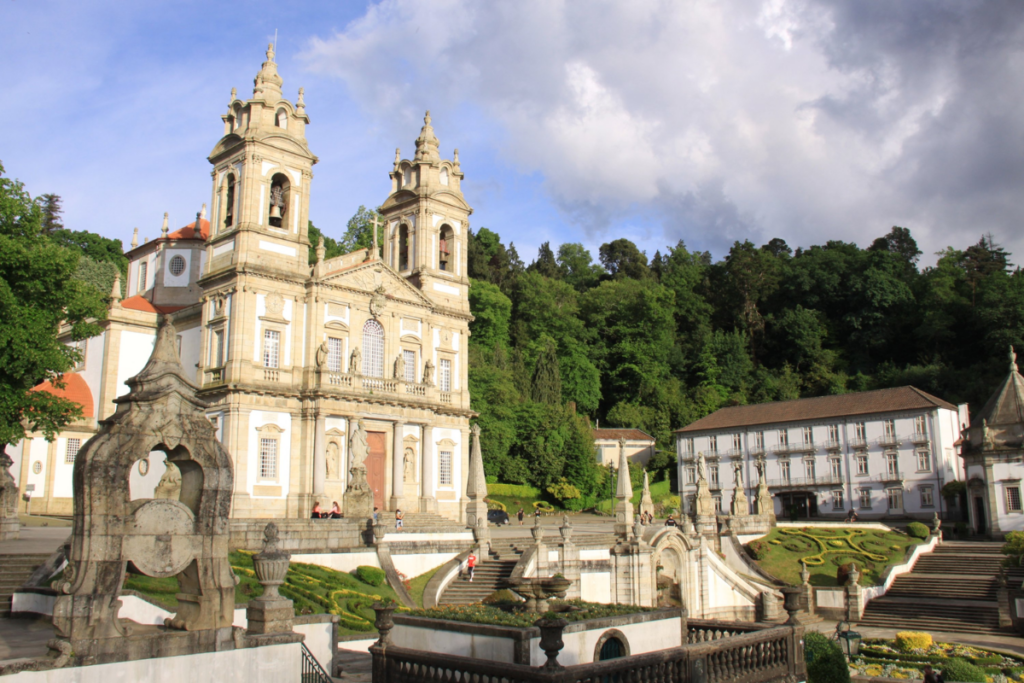
Braga, often referred to as the “Religious Heart of Portugal,” is a city steeped in spiritual significance and history. As one of the oldest cities in the country, Braga has been a center of Christian faith for centuries, earning it the title of the “Rome of Portugal.” With its magnificent churches, sanctuaries, and religious festivals, Braga is a must-visit destination for those interested in Portugal’s religious heritage.
Bom Jesus do Monte
One of the most iconic religious sites in Braga is the sanctuary of Bom Jesus do Monte. Perched on a hill overlooking the city, this sanctuary is famous for its monumental Baroque staircase, which symbolizes the ascent to heaven. Pilgrims and visitors alike can either climb the 577 steps or take the funicular to reach the top, where they are rewarded with breathtaking views and a peaceful atmosphere.
Braga Cathedral (Sé de Braga)
As the oldest cathedral in Portugal, the Braga Cathedral holds immense religious and historical importance. Its construction dates back to the 12th century, and over the centuries, it has been expanded and renovated, showcasing a blend of architectural styles from Romanesque to Gothic to Baroque. Inside, visitors can admire the ornate chapels, stunning altarpieces, and the tombs of Portuguese royalty.
Santa Barbara Garden (Jardim de Santa Bárbara)
Located in the heart of Braga, the Santa Barbara Garden is a beautifully landscaped garden adjacent to the Archbishop’s Palace. The garden is known for its well-maintained flower beds, charming fountains, and peaceful ambiance. It’s a perfect spot for reflection and relaxation after exploring the city’s religious sites.
Festivals and Events
Braga is also known for its vibrant religious festivals, with Holy Week (Semana Santa) being the most significant. During Holy Week, the city comes alive with processions, religious ceremonies, and cultural events that attract visitors from all over the world. The Festas de São João, dedicated to Saint John the Baptist, is another major celebration that fills the streets with parades, music, and traditional festivities.
Guimarães: The Birthplace of Portugal
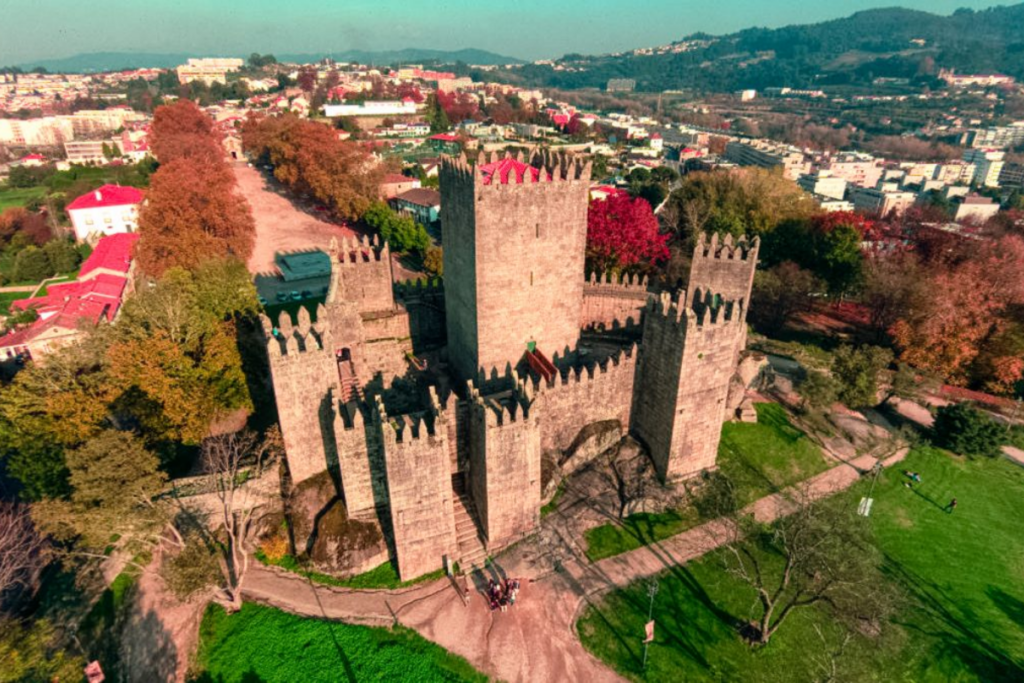
Guimarães is often referred to as the “Birthplace of Portugal” due to its significant role in the country’s history. It was here that Afonso I, the first King of Portugal, was born and where the Battle of São Mamede took place in 1128, leading to the foundation of the Portuguese nation. The city’s well-preserved medieval architecture and deep historical roots make it a must-visit destination for those interested in the origins of Portugal.
- Guimarães Castle: Perched on a hill overlooking the city, Guimarães Castle is a symbol of Portugal’s birth as a nation. Built in the 10th century to defend against Moorish and Norman invasions, the castle offers a glimpse into Portugal’s medieval past. Visitors can explore the towers and walls, enjoying panoramic views of the surrounding area.
- Palace of the Dukes of Braganza: Located near Guimarães Castle, the Palace of the Dukes of Braganza is a striking example of 15th-century architecture. The palace was the residence of the Dukes of Braganza, one of the most powerful noble families in Portugal. Today, it houses a museum with an impressive collection of tapestries, furniture, and armor from the period.
- Historic Centre of Guimarães: The historic center of Guimarães is a UNESCO World Heritage site, recognized for its well-preserved medieval buildings and cobblestone streets. Walking through the center feels like stepping back in time, with its charming squares, ancient churches, and traditional houses. Key sites within the historic center include the Church of Nossa Senhora da Oliveira and the Largo da Oliveira square.
Cultural Heritage and UNESCO Status
Guimarães is not just a city with historical importance; it is a living testament to Portugal’s cultural heritage. The city’s designation as a UNESCO World Heritage site underscores its significance in the story of Portugal’s formation. The preservation of its medieval architecture and the city’s active cultural scene ensure that Guimarães remains a vibrant part of Portugal’s national identity.
Óbidos: The Medieval Marvel
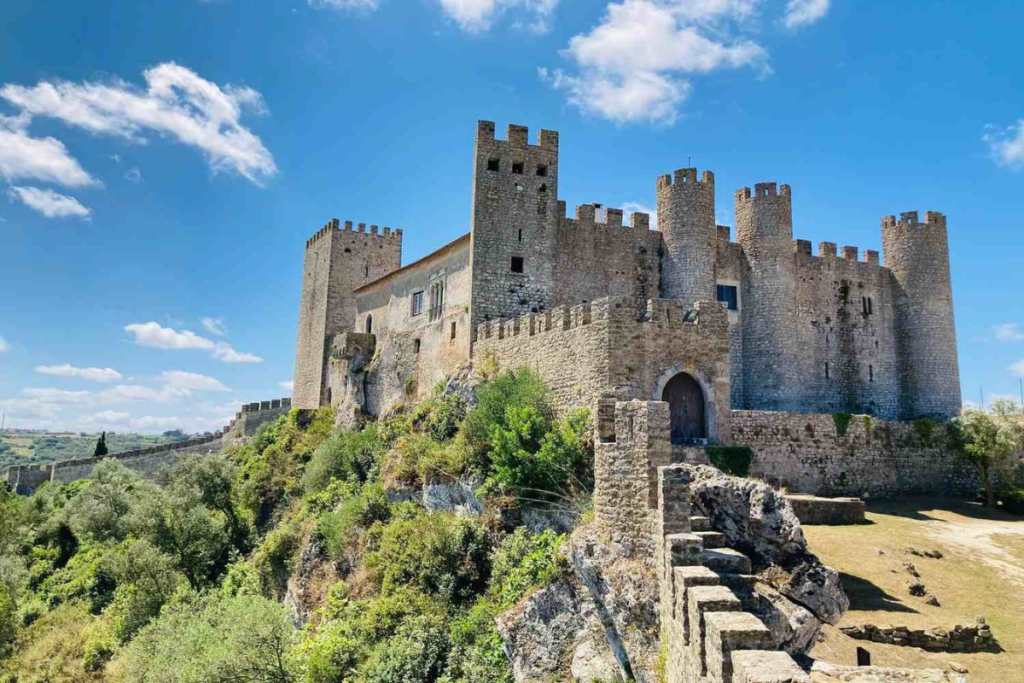
Óbidos is a delightful medieval town that transports visitors back in time with its well-preserved architecture and enchanting atmosphere. Known for its cobbled streets, historic buildings, and imposing castle, Óbidos offers a unique glimpse into Portugal’s rich past.
- Óbidos Castle: Dominating the town’s skyline, Óbidos Castle is a magnificent example of medieval military architecture. Walk along the castle walls for panoramic views of the surrounding countryside and the charming town below.
- Porta da Vila: This picturesque gateway is the main entrance to the town and features a beautiful blue-tiled facade that exemplifies traditional Portuguese azulejos (ceramic tiles). It’s a perfect spot for a photo op as you enter the medieval heart of Óbidos.
- Óbidos Lagoon: Just outside the town, Óbidos Lagoon is a serene spot known for its natural beauty. It offers opportunities for kayaking, bird-watching, and enjoying the tranquil environment.
- Óbidos Medieval Market: Held annually, this vibrant market recreates the medieval atmosphere with stalls selling crafts, food, and traditional goods. It’s a lively event where visitors can experience medieval entertainment and festivities.
- Chocolate Festival: Another annual highlight in Óbidos is the Chocolate Festival, where chocolate lovers can indulge in a variety of delicious treats. The festival showcases chocolate creations from local and international artisans and provides a sweet experience for all ages.
Best time to visit Óbidos
The best time to visit Óbidos is during the spring or fall when the weather is pleasant and the town’s annual events add to the festive atmosphere.
Funchal: The Capital of Madeira
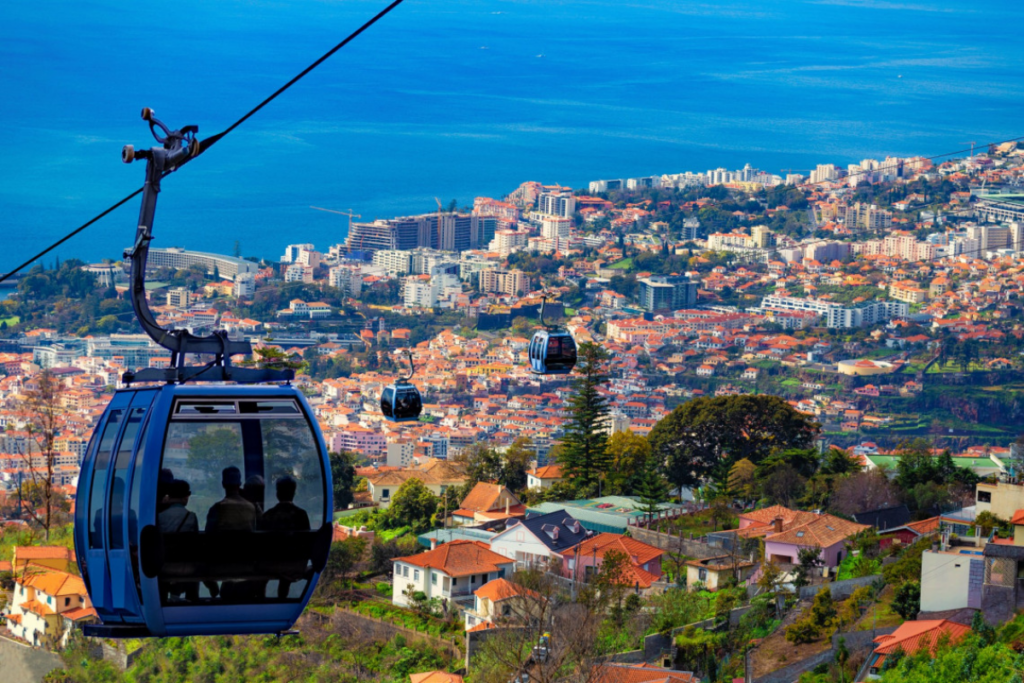
Funchal, the capital city of Madeira, is a captivating destination known for its stunning landscapes, rich history, and vibrant culture. Nestled on the southern coast of the island, Funchal offers a mix of natural beauty and historical charm, making it a must-visit spot for travelers to Portugal.
- Monte Palace: Perched on a hill overlooking Funchal, Monte Palace is a beautiful estate featuring exotic gardens, impressive tile collections, and panoramic views of the city. You can reach Monte Palace by taking the historic Monte cable car, which offers spectacular views of the surrounding landscape.
- Madeira Botanical Garden: This lush garden is a paradise for nature lovers. With its diverse collection of tropical and subtropical plants, the Madeira Botanical Garden provides a serene escape and stunning views over Funchal. The garden also features various themed sections, including a cactus garden and an aromatic herb garden.
- Farmers’ Market (Mercado dos Lavradores): Located in the heart of Funchal, the Mercado dos Lavradores is a vibrant market offering a taste of Madeira’s local culture. Here, you can explore stalls selling fresh fruits, vegetables, local cheeses, and traditional Madeira wines. The market’s colorful atmosphere and array of local products make it a great place to experience the island’s culinary delights.
Best time to visit Funchal
The ideal time to visit Funchal is from April to October when the weather is warm and sunny. The spring and summer months are particularly pleasant for outdoor activities and sightseeing.
Local tips
Try local specialties such as Madeira wine and the famous “Bolo do Caco” bread.
Consider taking a guided tour to fully appreciate the history and natural beauty of Funchal.
Wear comfortable shoes for exploring the city’s hilly streets and gardens.
Douro Valley: The Scenic Wine Region
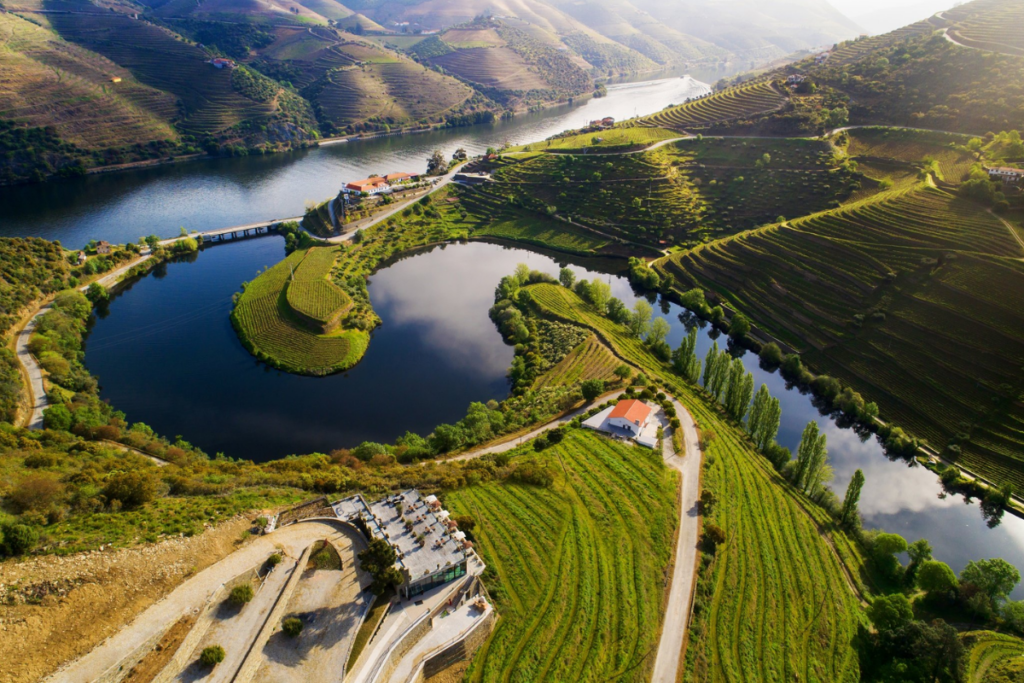
The Douro Valley, located in northern Portugal, is one of the country’s most picturesque and renowned wine regions. This UNESCO World Heritage site is celebrated for its stunning landscapes, terraced vineyards, and exceptional port wine.
- Wine Tasting Tours and Vineyard Visits: The Douro Valley is home to numerous wine estates where you can explore traditional winemaking processes and sample some of Portugal’s finest wines. Renowned for its port wine, the region offers a range of tasting experiences, from intimate tours at family-run estates to luxurious tastings at high-end wineries.
- Scenic Drives: A drive through the Douro Valley provides breathtaking views of rolling hills, terraced vineyards, and the winding Douro River. The N222 road, in particular, is famous for its scenic beauty and is considered one of the most beautiful drives in the world.
- Boat Tours on the Douro River: For a unique perspective of the valley, consider taking a boat tour along the Douro River. These tours offer stunning views of the terraced vineyards and majestic landscapes, making for a relaxing and picturesque experience.
Best time to visit the Douro Valley
The best time to visit is during the harvest season (September to October) when you can experience the vibrant wine culture and witness the grape harvest, or in the spring (April to June) for pleasant weather and blooming landscapes.
Peniche: A Surfer’s Paradise

Peniche, located on Portugal’s western coast, is renowned for its spectacular coastal beauty and world-class surfing conditions. This charming town is a hotspot for both seasoned surfers and casual beachgoers, offering a perfect blend of sandy shores and rugged cliffs.
- Supertubos: Often referred to as the “European Pipeline,” Supertubos is one of the best surf spots in Portugal. Known for its powerful and perfectly formed waves, it attracts surfers from around the world. The beach’s dramatic waves and consistent swells make it ideal for both experienced surfers and competitive events.
- Baleal Beach: Just a short drive from Peniche, Baleal Beach is a favorite among surfers and families alike. Its long stretch of sand and reliable waves provide excellent conditions for surfing, while its scenic beauty makes it a great place to relax and enjoy the sun.
- Berlengas Archipelago: A short boat trip from Peniche, the Berlengas Archipelago is a stunning natural reserve consisting of a group of islands. The archipelago features dramatic cliffs, crystal-clear waters, and a unique ecosystem. Visitors can explore the rugged landscape, go snorkeling, or simply enjoy the tranquil environment.
- Peniche Fortress: Overlooking the harbor, Peniche Fortress is a historical site that offers insights into the region’s past. The fortress, built in the 16th century, provides panoramic views of the surrounding area and is a great spot for history enthusiasts.
Peniche’s combination of top surf spots and natural attractions makes it a must-visit destination for those seeking adventure and relaxation along Portugal’s picturesque coastline.
Nazare: The Big Wave Beach
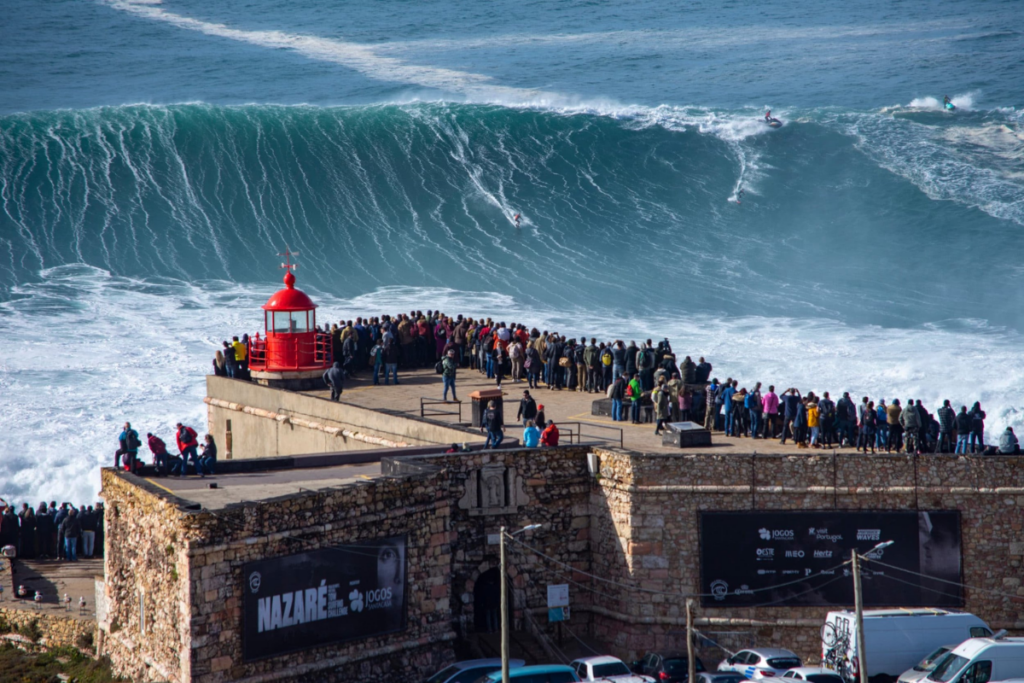
Nazare is renowned globally for its colossal waves, making it a prime destination for surfing enthusiasts and thrill-seekers. Located along Portugal’s western coast, this small town has gained legendary status in the surfing world for its record-breaking waves that can reach up to 100 feet high. The underwater Nazaré Canyon funnels ocean swells toward the shore, creating these enormous waves that attract surfers from around the globe.
- Best Time to Visit: The best time to visit Nazare for surfing and wave watching is from October to March. During these months, the swells are at their peak, providing optimal conditions for surfing and witnessing the awe-inspiring big waves. For a more relaxed visit, summer months offer warmer weather and a more subdued ocean.
- Nazare Beach: The town’s main attraction, Nazare Beach, is a beautiful stretch of sand where visitors can relax, swim, and watch the impressive waves. The beach is also a great spot for taking in the scenic views of the Atlantic Ocean.
- Sanctuary of Our Lady of Nazare: This religious site is an important pilgrimage destination. The sanctuary houses the statue of Our Lady of Nazare, which is believed to have miraculous powers. The site offers a peaceful retreat and a glimpse into the local culture and traditions.
Nazare’s blend of thrilling surf conditions and cultural landmarks makes it a unique destination that appeals to both adventure seekers and those looking to experience Portuguese heritage.
Cascais: The Luxurious Coastal Town
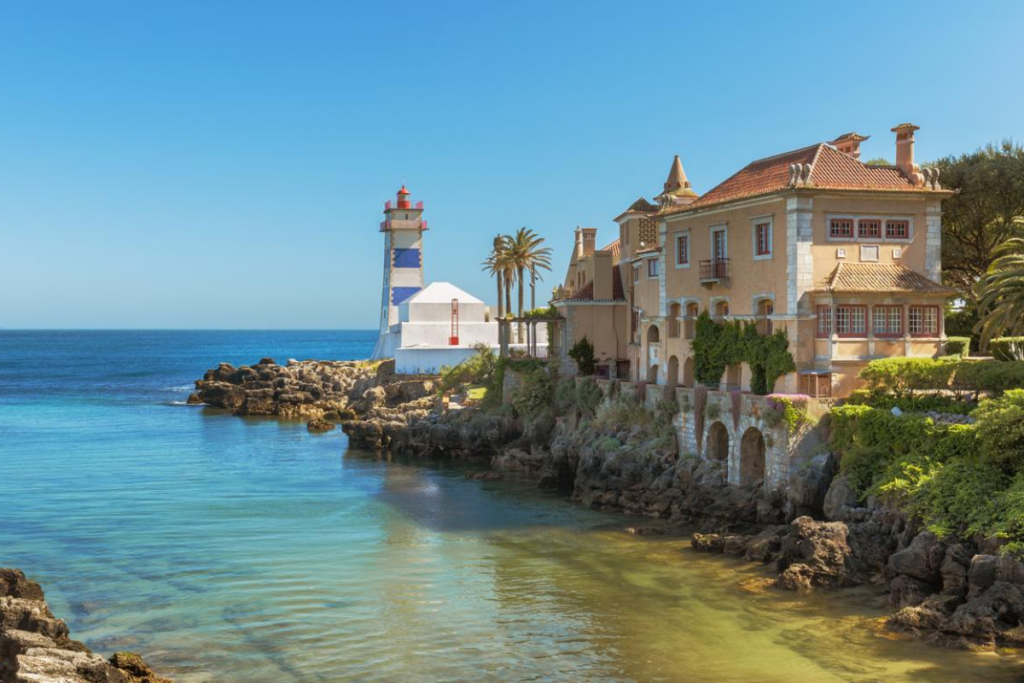
Cascais is a picturesque coastal town known for its blend of luxury, natural beauty, and historic charm. Located just a short drive from Lisbon, Cascais offers an ideal escape with its stunning beaches, vibrant marina, and elegant ambiance. Once a fishing village, it has transformed into a sophisticated destination that attracts both locals and international visitors.
- Boca do Inferno: Boca do Inferno, or “Hell’s Mouth,” is a dramatic natural wonder where the sea has carved out a stunning grotto in the cliffs. The roaring waves create a mesmerizing spectacle, especially during high tide and stormy weather.
- Cascais Marina: The marina is a lively spot where visitors can admire luxury yachts, enjoy waterfront dining, and explore boutique shops. It serves as a hub for various water activities, including sailing and boat tours.
- Guincho Beach: Renowned for its golden sands and powerful waves, Guincho Beach is a paradise for surfers and beachgoers. Its rugged beauty and natural surroundings make it a popular spot for both relaxation and adventure.
Best time to visit Cascais
The ideal time to visit Cascais is during the spring (April to June) and fall (September to October). The weather is pleasant, and you can avoid the peak summer crowds while still enjoying warm temperatures.
Travel tips
Cascais is easily accessible from Lisbon via a short train or car ride. The town is compact and walkable, making it convenient to explore on foot. For a more luxurious experience, consider staying at one of the upscale hotels or resorts along the coastline.
Practical Travel Tips for Portugal
When planning your trip to Portugal, keeping a few practical travel tips in mind can help you make the most of your visit. Here’s a guide to ensure a smooth and enjoyable experience.
Best Times to Visit Different Regions
- Lisbon and Porto: The ideal times to visit Lisbon and Porto are during the spring (March to May) and fall (September to October). During these periods, you’ll enjoy pleasant weather and fewer tourists compared to the peak summer months.
- Algarve: The Algarve region, famous for its beaches, is best visited from late spring (May) to early fall (September). Summer is the peak season with warmer temperatures and more tourists, while late spring and early fall offer a balance of good weather and fewer crowds.
- Madeira and Azores: Madeira is lovely year-round, but the spring and fall offer the best weather for outdoor activities. The Azores are great to visit from June to September when the weather is warm and dry, ideal for exploring the islands and enjoying outdoor adventures.
Transportation Options
- Trains: Portugal has an extensive and efficient rail network. The Comboios de Portugal (CP) offers connections between major cities like Lisbon, Porto, and Coimbra. The Alfa Pendular trains provide high-speed service on key routes, making travel convenient and comfortable.
- Buses: For destinations not covered by the train network, buses are a reliable option. Companies like Rede Expressos offer long-distance and regional services across Portugal, including to and from smaller towns and rural areas.
- Car Rentals: Renting a car is an excellent way to explore Portugal at your own pace, especially if you plan to visit rural areas or the Algarve’s hidden beaches. Major cities have car rental agencies, and driving in Portugal is generally straightforward.
Language Tips and Cultural Etiquette
- Language: Portuguese is the official language of Portugal. While many people in tourist areas speak English, learning a few basic Portuguese phrases can enhance your travel experience. Simple greetings and polite expressions like “Bom dia” (Good morning) and “Obrigado/a” (Thank you) are appreciated.
- Cultural Etiquette: Portuguese people are known for their hospitality. It’s customary to greet people with a handshake or a kiss on both cheeks among friends. When dining out, it’s polite to wait for everyone to be served before starting your meal. Tipping is customary, with 5-10% being a standard practice in restaurants.
By following these practical tips, you’ll be well-prepared to navigate Portugal and make the most of your visit to this beautiful and diverse country.
FAQs About the Best Places to Visit in Portugal
What is the nicest part of Portugal to visit? The nicest part of Portugal to visit often depends on personal preferences, but Lisbon and the Algarve are consistently popular. Lisbon offers a blend of historic charm and modern attractions, while the Algarve is known for its stunning beaches and picturesque coastal towns.
Which part of Portugal is the most beautiful? The Douro Valley is often regarded as one of the most beautiful parts of Portugal, with its rolling hills, terraced vineyards, and the scenic Douro River. Sintra, with its fairy tale palaces and lush landscapes, is also frequently cited as one of the most beautiful areas in the country.
Where to visit for the first time in Portugal? First-time visitors to Portugal should consider starting in Lisbon, the vibrant capital, followed by a trip to Porto and the nearby Douro Valley. Exploring the Algarve’s stunning beaches or the historical town of Sintra can also be a great introduction to the country.
Best places to visit in Portugal for first timers? For first-timers, Lisbon, Porto, Sintra, and the Algarve are must-see destinations. These areas offer a well-rounded experience of Portugal’s culture, history, and natural beauty.
Best places to visit in Portugal for couples? Sintra, with its romantic palaces and gardens, is ideal for couples. Porto, known for its cozy wine cellars and scenic riverside views, is also a top choice. The Algarve offers beautiful beaches and sunsets that are perfect for a romantic getaway.
Top 10 places to visit in Portugal?
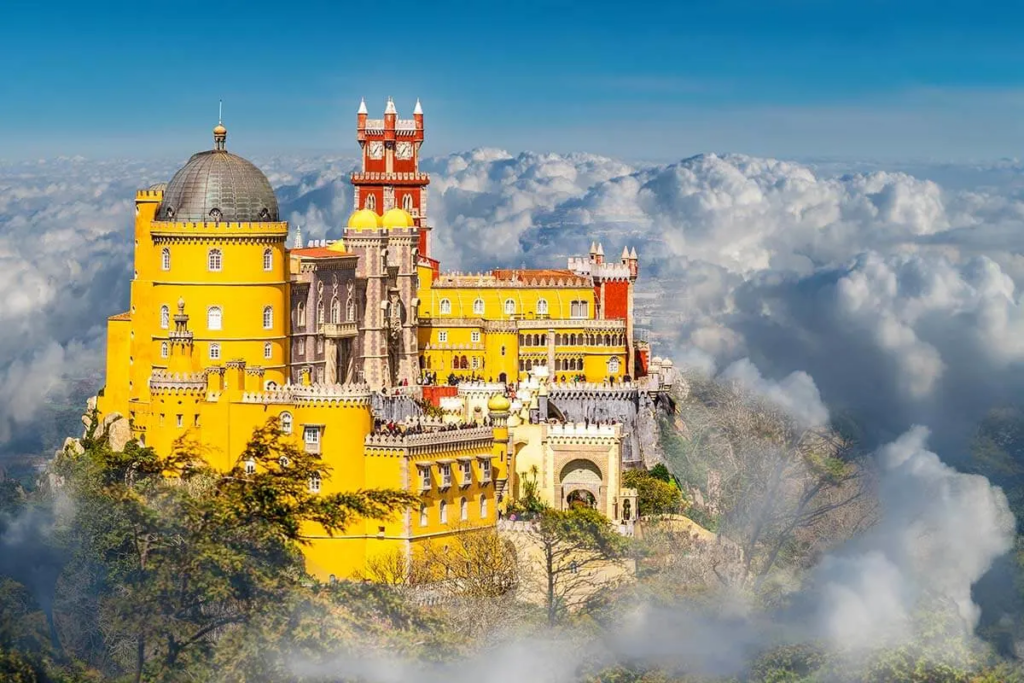
- Lisbon
- Porto
- Sintra
- Algarve
- Douro Valley
- Coimbra
- Madeira
- Azores
- Évora
- Braga
Best places to visit in Portugal for young adults? Young adults might enjoy Lisbon and Porto for their lively nightlife, cultural experiences, and vibrant arts scenes. The Algarve, known for its outdoor activities and beach parties, is also a great destination.
Best places to visit in Portugal with family? The Algarve is excellent for families, offering safe beaches and family-friendly resorts. Lisbon and Porto also provide plenty of attractions suitable for children, including interactive museums and parks.
Best places to visit in Portugal Algarve? In the Algarve, some of the best places to visit include Lagos for its historic center and cliffs, Albufeira for its beaches and nightlife, and Praia da Marinha, known for its stunning coastal scenery.
Best places in Portugal for holiday? The Algarve is one of the top holiday destinations in Portugal, especially for beach lovers. Lisbon and Porto are also great for a city break, offering a mix of culture, history, and modern amenities.
Unique places to visit in Portugal? Unique places include the volcanic landscapes of the Azores, the isolated Berlengas Archipelago off the coast of Peniche, and the mystical Quinta da Regaleira in Sintra, known for its enigmatic architecture and hidden tunnels.
Conclusion
Portugal is a land of endless discovery, offering a diverse array of attractions that cater to every traveler’s interests. From the vibrant streets of Lisbon and the historic charm of Porto to the sun-kissed beaches of the Algarve and the lush landscapes of Madeira, each destination has its unique appeal. Whether you’re drawn to the rich cultural heritage, stunning natural beauty, or the warm hospitality of its people, Portugal promises an unforgettable experience.
Exploring Portugal’s hidden gems is a journey through time and nature, where ancient castles, scenic wine regions, and quaint towns reveal the country’s soul. Whether you’re an adventure seeker, a history enthusiast, or someone looking to relax by the ocean, Portugal has something special for you.
So why wait? Plan your trip to Portugal now and immerse yourself in a country where every corner holds a new adventure, and every experience becomes a cherished memory. Your Portuguese journey awaits!
Read More: Discover the Hidden Gems: Unique Places to Visit in South Australia
Top 25 Must-Places To Visit in Victoria, Australia: Your Ultimate Travel Guide
Top Places To Visit in NSW: Your Ultimate New South Wales Travel Guide
Ultimate Guide to the Best Places to Visit in Geelong: Top Attractions and Hidden Gems






